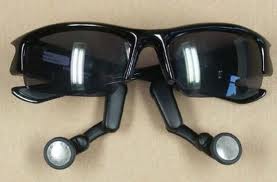History and Uses of Sunglasses
History
Sunglasses are used to aid your vision. Generally, it features darkened or colored lenses to protect the eyes from strong lights. It was said that Nero, a Roman Emperor watched fights of gladiators via polished gems, most likely emeralds.
The first usage of sunglasses was recorded during the 12th century in China. The lenses were made of smoky quarts flattened into panes. This does not provide corrective powers but the eyes are protected from glare. According to contemporary documents, the judges in Chinese Trial Courts used sunglasses to hide their facial expression while probing witnesses. This is similar on the Blind Justice representation in Western arts.
During the 18th century, James Ayscough started to experiment with colored lenses in eyeglasses. These are not considered as sunglasses because Ayscough believed that green or blue tinted glass corrects certain vision impairments. He was not concerned about the UV protection.
At the turn of the 1900s, wearing sunglasses became more popular and widespread in silent movies. The stars wear sunglasses not only to protect their eyes from the studio's harsh bright lighting but to avoid from being recognized.
In 1929, Sam Foster introduced mass-produced inexpensive sunglasses to America. He found ready markets on New Jersey and Atlantic City's beaches, selling his merchandise in the name of Foster Grant.
In 1936, sunglasses were polarized by Edwin H. Land using an original Polaroid filter. Oakley in 2004 created Thump. These sunglasses are equipped with a digital audio player that is built-in. Many smaller companies have copied this design.
Uses
• Hide the eyes during one on one communication. Typically, it hides weeping which is a sign of mourning, makes eye contacts impossible which is sometimes very intimidating, and shows detachment in some groups. Other reasons include hiding contracted or dilated pupils and bloodshot eyes (caused by drug use or physical abuse) and compensating for optimum photosensitivity.
• Fashion accessory. Wearing sunglasses always have a purpose. Darkened sunglasses in different shapes are a type of accessory. Compared to normal eyeglasses which can project a nerdy image, sunglasses are worn indoors or at night for projecting cool images and nonverbal communications.
• Hide serious visual impairments. It includes blindness, cross eyed condition, and abnormal appearance of the eyes because of cataract and nystagmus (uncontrollable jerking of the eyes). People wear sunglasses to prevent others from becoming uncomfortable.
• Visual comfort and clarity. Sunglasses protect the eyes from glare. Sometimes, a patient who received mydriatic eye drops is required to wear even disposable sunglasses after eye examinations.
• Protection. Prolonged exposure to UV rays causes long-term or short-term ocular problems including snow blindness, pterygium, photokeratitis, and some types of eye cancers. Medical experts revealed that wearing sunglasses is important for eye protection from UV rays. However, health authorities warn the public not to look at the sun during a solar eclipse using only sunglasses.
CE mark in the European Union identifies sunglasses that passed quality regulations. Keep in mind that there is also no connection between increased ultraviolet protection and high prices of sunglasses. Based on the 1995 study, polarizing sunglasses and expensive brands never guarantee a maximum UVA protection. The ACCC (Australian Competition and Consumer Commission) reports that consumers should never rely on prices as indicators of quality. Some unscientific survey revealed that there are generic sunglasses costing 6.95 dollars providing slightly better UV protection than Salvatore Ferragamo and Michael Kors shades. Oakley sunglasses have passed the requirements of the ANSI (American National Standards Institute) Z87.1 offering UV protection.
Most recently, HEV (high energy visible light) has been associated with macular degeneration related to age. Several manufacturers create sunglasses for blocking it. Children are also advised to wear UV protected sunglasses since their ocular lenses transmits significant amount of HEV light as compared to adults.
Some sunglasses even pass the requirements of ANSI Z87.1 for high impact and basic impact protection. However, compliance to these standards are voluntary. Therefore, not all manufacturers or sunglasses are required for compliance. Basically, the impact test is conducted by dropping a 2.54cm (1 inch) steel ball on the lenses from a height of 127 cm (50 inches). The test for high velocity is done by shooting a 6.35 mm (1/4 inch) steel ball at the lenses at a speed of 45.72m/s (150ft/s).To pass both tests, no part of the lenses should touch the eyes.


No comments:
Post a Comment